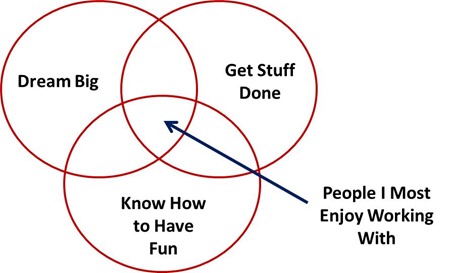I decided to add a Thursday post this week to break up the rheology series. I know some of our readers may not be as “into” rheology as some. We have a long list of pretty technical blog posts scheduled (Dr. Prime will be back with a series of posts on thermoset cure kinetics and Dr. Humphreys will have additional posts on biopolymers). So I have decided to add in a “Thursday Break Up” on a different topic (with maybe a little irreverance).
As the owner of a boutique consulting company, I often ask “who would be an ideal client,” or you might ask, “what would be an ideal company to work for,” or “organization I would want to volunteer at?”
Check out the following Venn diagram (yea, I am the techie thru-and-thru!):
Let’s look at each of the elements.
- Dream Big: Why not have a big bold idea? Jim Collins calls them BHAG;s, Big Hairy Audacious Goals. Steve jobs at Apple was obsessed with making things that were “insanely cool.” Elon Musk’s recent companies were Space X and Tesla Motors. Talk about dreaming big; space ships and luxury electric cars. This list of companies that dream big is actually pretty short (unfortunate). Dreaming big is hard work. Ideas often fail, or failure occurs along the way. Big dreams keep you focused on the bigger goal, the game changer.
- Get Stuff Done: The best companies I have worked for (or were my clients) had a culture of execution. They just knew how to get sh*t done (that was the original wording in the diagram, but I toned it down for the image). The people had a can-do attitude and minor/major roadblocks were thought of as just part of excitement. Getting stuff done is a key to successful innovation, product development, and manufacturing. Set-backs happen, the best know how to rally and push through the obstacles. I see risk aversion in many companies (including leaders) as hindering getting stuff done. I once knew a leader who wanted bigger, bolder projects, but wondered why they weren’t getting done. Well, if an employee failed or had a setback, they got killed. So much for bigger, bolder projects.
- Know How to Have Fun: I left this for last (and the base in the above Venn diagram) since this is the most important. I hear from many of my buddies still in corporate America that it just isn’t fun anymore. What a shame. Most employees spend 2080 hours/year (less vacations and holidays and maybe more if you work a lot of overtime) working. That’s a lot of hours. So why not have fun? Having fun isn’t just having a great breakroom (with game tables), cafeteria, or basketball courts (but they help), but people who really enjoy working have fun. They wake up each day excited to go to work. Actually, they don’t think of it as work. More creativity happens. Look at some of the more successful start-ups and you will see people having fun. Why do large corporations seemingly kill having fun? They do that at their own detriment.
So where you work do you have fun? get stuff done? big, hairy audacious goals? That’s the kind of place I like to work with. How about you?


Leave a Reply